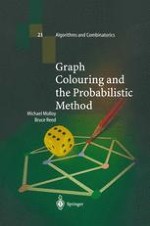2002 | OriginalPaper | Chapter
Probabilistic Preliminaries
Authors : Michael Molloy, Bruce Reed
Published in: Graph Colouring and the Probabilistic Method
Publisher: Springer Berlin Heidelberg
Included in: Professional Book Archive
Activate our intelligent search to find suitable subject content or patents.
Select sections of text to find matching patents with Artificial Intelligence. powered by
Select sections of text to find additional relevant content using AI-assisted search. powered by
We consider experiments which have only a finite number of possible outcomes. We call the set of all possible outcomes, the sample space and denote Ω. For example, our experiment may consist of rolling a six sided die and examining the top face, in which case Ω. = {1, 2, 3, 4, 5, 6}. Alternatively, our experiment may consist of flipping a coin three times in a row, then Ω = {HHH, HHT, HTH, THH, TTH, THT, HTT, TTT} where H stands for heads and T for tails. The reader probably has an intuitive notion of what an event is, which corresponds to this word’s use in everyday language. Formally, an event is a subset A of Ω. For example, we identify the event that the die roll is odd with the subset ({1, 3, 5}). Similarly, the event that the coin landed the same way up every time is the set ({HHH, TTT}).
